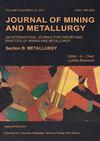Magnesium extraction of ferronickel slag processed by alkali fusion and hydrochloric acid leaching
IF 1
4区 材料科学
Q3 METALLURGY & METALLURGICAL ENGINEERING
Journal of Mining and Metallurgy Section B-Metallurgy
Pub Date : 2021-01-01
DOI:10.2298/JMMB200224018P
引用次数: 2
Abstract
A research using ferronickel slag, the by-product of ferronickel production, as raw material for magnesium extraction has been carried out. It is essential to upgrade the value of ferronickel slag instead of used directly for reclamation materials. Moreover, accumulation due to increasing ferronickel demand as well as environmental contamination due to various potencially toxic elements contained in the ferronickel slag could be prevented. The general objective of this study is to utilize the ferronickel slag for magnesium materials. The specific objective is to determine the optimum conditions of magnesium extraction in the process of alkali fusion followed by hydrochloric acid leaching. A novel method for magnesium extraction from ferronickel slag was carried out through reducing silica content followed by acid leaching method. Alkali fusion of the mixture of ferronickel slag and Na2CO3 at 1000 ?C for 60 minutes followed by water leaching at 100 ?C for 60 minutes with solid to liquid percentage of 20 % were carried out to separate the silica. The leaching residue resulted from water leaching was then leached using hydrochloric aid solution to extract magnesium. The leaching temperature and time as well as the hycrochloric acid concentration were varied in the acid leaching process. Alkali fusion process proved can be generated the sodium silicate that can be separated in the water leaching to the leached solution. Meanwhile, the leaching residue was leached using hydrochloric acid to extract the magnesium. The highest magnesium extraction percentage is 82.67% that resulted from an optimum acid leaching condition with temperature of 80 ?C for 30 minutes using 2M HCl solution. Based on the kinetics study, the activation energy (Ea) for the leaching reaction of magnesium at atmospheric pressure between 32?C to 80?C is 9.44 kJ/mol and affected by diffusion and chemical reactions.碱熔-盐酸浸出法处理镍铁渣的提镁
以镍铁生产副产物镍铁渣为原料进行了提镁研究。提高镍铁渣的利用价值,而不是直接作为回收材料。此外,还可以防止镍铁渣中各种潜在有毒元素对环境的污染。本研究的总体目标是利用镍铁渣制备镁材料。具体目的是确定碱熔后盐酸浸出工艺中提取镁的最佳条件。采用酸浸法先降低氧化硅含量,再从镍铁渣中提取镁。将镍铁渣与Na2CO3的混合物在1000℃下碱熔60分钟,然后在100℃下以固液比20%的比例水浸60分钟,分离出二氧化硅。然后用盐酸助浸液对水浸渣进行浸出,提取镁。酸浸过程中,浸出温度、浸出时间和盐酸浓度都发生了变化。经证明,碱熔工艺可产生水玻璃,水玻璃可在浸出液中分离出来。同时,对浸出渣进行盐酸浸出,提取镁。最佳酸浸条件为:温度为80℃,盐酸浓度为2M,酸浸时间为30 min,镁的提取率为82.67%。在动力学研究的基础上,得到了常压下32?摄氏到八十度?C为9.44 kJ/mol,受扩散和化学反应的影响。
本文章由计算机程序翻译,如有差异,请以英文原文为准。
求助全文
约1分钟内获得全文
求助全文
来源期刊
CiteScore
2.00
自引率
40.00%
发文量
19
审稿时长
2 months
期刊介绍:
University of Belgrade, Technical Faculty in Bor, has been publishing the journal called Journal of Mining and Metallurgy since 1965 and in 1997 it was divided in two independent journals dealing with mining and metallurgy separately. Since 2009 Journal of Mining and Metallurgy, Section B: Metallurgy has been accepted in Science Citation Index Expanded.
Journal of Mining and Metallurgy, Section B: Metallurgy presents an international medium for the publication of contributions on original research which reflect the new progresses in theory and practice of metallurgy. The Journal covers the latest research in all aspects of metallurgy including hydrometallurgy, pyrometallurgy, electrometallurgy, transport phenomena, process control, solidification, mechanical working, solid state reactions, materials processing, surface treatment and relationships among processing, structure, and properties of materials.

 求助内容:
求助内容: 应助结果提醒方式:
应助结果提醒方式:


